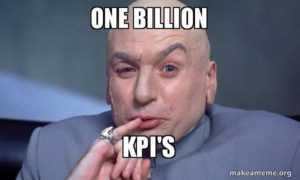Happy budget season! Yes, it’s that time of year again, time to put together your digital marketing budget for 2023!
This can be a stressful time for marketers. You must make your case all over again for the funds you need to achieve digital marketing success.
Do you dread this presentation? Never fear, we have a fool-proof process for getting the funds you need all while getting the entire team excited about marketing.
Yes, you read that right. It’s time to get the whole team on the same page so everyone is a fervent supporter of your digital marketing efforts!
This guide will help you nail your budget pitch this year!
Go into Your Digital Marketing Budget Meeting with Confidence!
We all know the age-old story; a nervous marketer goes before their boss and begs for more budget. Why are we still doing things this way? We, as marketers, know that marketing is what gets sales their leads and helps an organization prosper and grow.
Everyone in your organization should take a vested interest in the success or failure of your marketing.
So, why are we still begging for money? If you’re sick of it, we offer you this simple process. It will set you on the path to marketing budget success and make you the hero of the company. It looks like this…
- Get your sales team involved right now.
- Talk to the money people early.
- Understand your customer’s wants and needs.
- Identify an SQL and work backward to MQLs.
- Define the activities that will get you the MQLs you need.
- Itemize all marketing assets: people and programs.
Let’s look at each of these…
Talk to Your Sales Team!
Get your sales team involved right now. Work with them to develop reasonable and achievable KPIs (key performance indicators, i.e. what success looks like). These are metrics you need to meet if the sales team wants to make their quota.
And these are the metrics that show the C-suite that you are contributing to the bottom line. In other words, job security.
You get these by analyzing the previous year’s performance. How much traffic and conversions did you get last year? Of those conversions, how many turned into MQLs (marketing qualified leads), SQLs (sales qualified leads), and closed sales?
Now, was that enough? That answer will inform what kind of goals you need to achieve in order for the sales team to get the leads they need to make their quota. If you can show sales that increased marketing activity and spending will help them make their quota (or exceed it), they will certainly have your back at budget time.
But the sales team doesn’t control the money.
Involve Your Finance Team
In addition to sales getting involved at the start, engage finance too – they create revenue goals with the sales team. Marketing then has to deliver the input to meet those sales goals.
Finance is the money marketing needs – you can align with sales but can still be denied the money because you didn’t get finance buy-in.
Talk to your money people early. Work with the CFO or whoever manages the books to understand how the previous year’s finances were allocated. If you are asking for more money, you will need to show finance that it will produce more revenue. A finance person is concerned about the bottom line.
If you go into your budget meeting asking for money that is either not there or that you cannot show will be there, you will lose them right out of the gates. Show the finance people that you understand their role in how money is allocated and that you want to make sure that everyone is on board for any changes to that.
You may not like what they have to say and might be denied more money, but if you can clearly show how your marketing efforts will improve the bottom line, they will see less risk and get on board with the spending you’re asking for.
Now that you secured support from finance and aligned your goals with sales, let’s start building a concrete budget plan. And the first step is to make sure you’re marketing to the right types of people.
What Does a Typical Client Look Like?
Understand your customers. Buyer personas and market research will produce some actionable intelligence, but it’s your salespeople who know your ideal customer best. What is the perfect lead for them? What does that person/company look like?
Of course, it may not be one type of person. It could be multiple personas, especially if you have multiple offerings. Make sure you have a clear understanding of each customer type and what their wants, needs, and problems are. What keeps them up at night?
How can your company help them? And how can your salespeople show them that your company offers them the ideal solution to their problems?
What materials will sales need to guide these people from awareness to conversion? This is where sales enablement activities will solidify your cooperation with the sales team. Sales enablement involves content that your sales team can use to show potential clients that your company understands their problems.
For example, our sales team can use this very post when working with a client who is trying to get the budget they need to hire Wellspring Digital.
You can also talk to customer service. They will be able to paint you a clear picture of what a happy client looks like. And they can show you where any of the usual issues are, i.e. what needs they have when contacting customer service.
This will also greatly inform your content marketing efforts and let you know what additional content is needed to keep current and future clients happy.
If you want to really nail down your audience’s wants and needs, try some real meaty buyer personas. These are the personas that Wellspring Digital Chats guests Ardath Albee and Adele Revella swear by.
Identify SQLs and Work Backward to MQLs
A sales-qualified lead (SQL) is what your salespeople are begging you for. Talk to your sales team and together, identify what an ideal SQL looks like. Then, work backward from there. Generally speaking, an SQL is someone who has the budget to make a purchase, the authority to do so, the need for that purchase, and the timing is right.
Budget, Authority, Need, Timing = BANT
How many of those SQLs does the sales team need to make their quota? They should be able to look at their win/loss ratio in your CRM and tell you that of X number of leads, they were able to close Y. Your job is to solve for X. Their job is to solve for Y.
From there, you should be able to determine how many MQLs you need to generate to get them X number of SQLs. An MQL is a person who has shown interest in your company with an activity like a download but has not yet been qualified as someone with BANT.
It is up to the sales team to qualify MQLs and determine if they are an SQL or not. Not all MQLs will turn into SQLs. But don’t toss them out if they do not convert. They may convert in the future.
So, how many MQLs does it take to generate one SQL? What marketing efforts will get you the MQLs you need? Now that you and the sales team have agreed on the definition of an MQL and SQL, it’s time to map out the marketing efforts required.
This includes things like SEO, content marketing, social media, drip campaigns, etc.
Itemize All Marketing Assets: People and Programs
Marketing Team – Internal Vs. Outsourced
What internal staff will you need to achieve your goals? Can any of those roles be outsourced to save money and increase production? For example, you might have a strong internal content team but are lacking when it comes to data analysis or vice versa.
Identify where you are strongest internally, then look at what outsourcing the rest will cost versus how it will contribute to your bottom line. You might determine, for example, that you need 5 white papers a quarter to generate the MQLs needed.
And maybe you do not have the team needed to generate those white papers. Should you hire or outsource? Go onto groups in your industry or talk to partner companies who are doing something similar. What do they do? What is the cost?
Here are some potential roles you will need to achieve your digital marketing goals. Any of these could be an internal staffer or an outsourced freelancer/company…
- Brand manager
- Content creator and/or manager
- Content marketer (if different from the creator which is common)
- Social media manager (if different from the content manager)
- SEO manager
- Webmaster
- Paid media manager
- Designer
- Marketing automation manager
- Subject matter expert (yes, this can be outsourced using a ghostwriter)
- Fractional CMO or vCMO
This list goes on but those are the usual suspects. Now, what kind of software will this team need to do their jobs?
Martech Stack
The marketing technology or martech stack your needs should depend on your marketing needs and not what the latest trends dictate. Based on the output and analysis you will need, what software will get it done?
- Marketing automation
- Analytics
- Social media management
- Communications
- Social listening and sentiment analysis
- Ad management
- And more
Mapping out the precise costs of everything and every person you need eliminates any budgeting guesswork. The C-suite hates guesses. They are looking for as much certainty as possible.
Is That Enough?
If you involve sales and finance early in the process, they will develop a sense of ownership in your marketing efforts and subsequently, your marketing budget. If you agree to KPIs, everyone is on the same page.
When they see how your marketing efforts help them in doing their job, they will go to bat for you when it’s budget-begging time.
And if you know exactly what an ideal client looks like and what activities are needed to drive sales and improve customer retention, the activities will sell themselves at “budget-begging time.”
In fact, you won’t have to beg at all because you’ve mapped out on paper exactly how marketing will support the company and make it successful.
The C-suite will be asking you, “is that enough?” Sounds crazy, but all they care about is the bottom line. If you show that the bottom line depends on your marketing efforts, they will want more and give you more budget accordingly.
Do you still need help with your digital marketing budget? Perhaps our vCMO services are what you need. Let’s talk.

